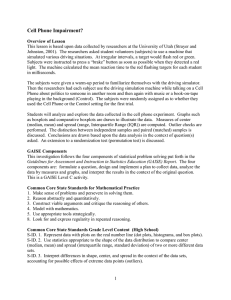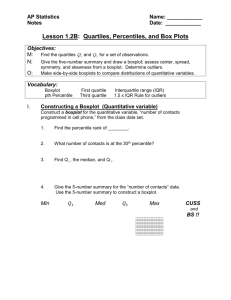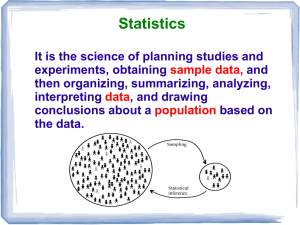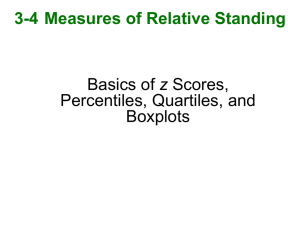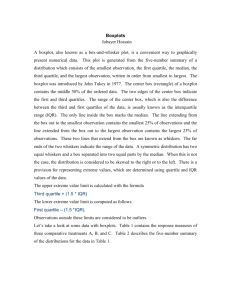Cell Phone Impairment?
advertisement
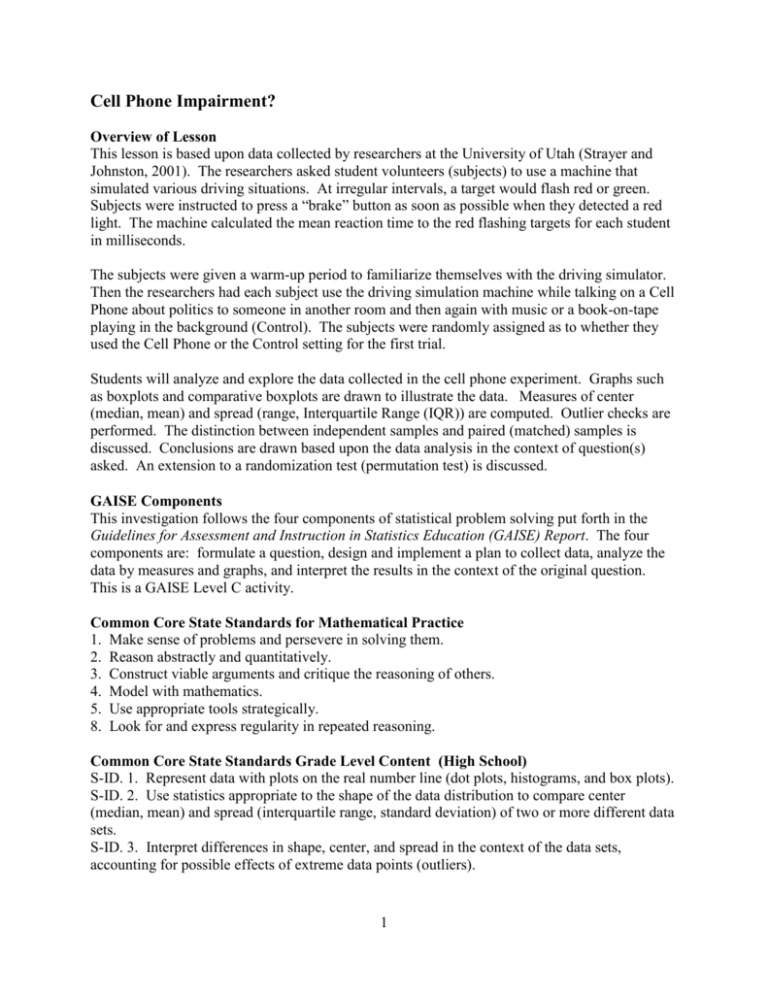
Cell Phone Impairment? Overview of Lesson This lesson is based upon data collected by researchers at the University of Utah (Strayer and Johnston, 2001). The researchers asked student volunteers (subjects) to use a machine that simulated various driving situations. At irregular intervals, a target would flash red or green. Subjects were instructed to press a “brake” button as soon as possible when they detected a red light. The machine calculated the mean reaction time to the red flashing targets for each student in milliseconds. The subjects were given a warm-up period to familiarize themselves with the driving simulator. Then the researchers had each subject use the driving simulation machine while talking on a Cell Phone about politics to someone in another room and then again with music or a book-on-tape playing in the background (Control). The subjects were randomly assigned as to whether they used the Cell Phone or the Control setting for the first trial. Students will analyze and explore the data collected in the cell phone experiment. Graphs such as boxplots and comparative boxplots are drawn to illustrate the data. Measures of center (median, mean) and spread (range, Interquartile Range (IQR)) are computed. Outlier checks are performed. The distinction between independent samples and paired (matched) samples is discussed. Conclusions are drawn based upon the data analysis in the context of question(s) asked. An extension to a randomization test (permutation test) is discussed. GAISE Components This investigation follows the four components of statistical problem solving put forth in the Guidelines for Assessment and Instruction in Statistics Education (GAISE) Report. The four components are: formulate a question, design and implement a plan to collect data, analyze the data by measures and graphs, and interpret the results in the context of the original question. This is a GAISE Level C activity. Common Core State Standards for Mathematical Practice 1. Make sense of problems and persevere in solving them. 2. Reason abstractly and quantitatively. 3. Construct viable arguments and critique the reasoning of others. 4. Model with mathematics. 5. Use appropriate tools strategically. 8. Look for and express regularity in repeated reasoning. Common Core State Standards Grade Level Content (High School) S-ID. 1. Represent data with plots on the real number line (dot plots, histograms, and box plots). S-ID. 2. Use statistics appropriate to the shape of the data distribution to compare center (median, mean) and spread (interquartile range, standard deviation) of two or more different data sets. S-ID. 3. Interpret differences in shape, center, and spread in the context of the data sets, accounting for possible effects of extreme data points (outliers). 1 S-IC. 1. Understand statistics as a process for making inferences about population parameters based on a random sample from that population. S-IC. 3. Recognize the purposes of and differences among sample surveys, experiments, and observational studies; explain how randomization relates to each. S-IC. 4. Use data from a sample survey to estimate a population mean or proportion; develop a margin of error through the use of simulation models for random sampling. S-IC. 5. Use data from a randomized experiment to compare two treatments; use simulations to decide if differences between parameters are significant. S-IC. 6. Evaluate reports based on data. NCTM Principles and Standards for School Mathematics Data Analysis and Probability Standards for Grades 9-12 Formulate questions that can be addressed with data and collect, organize, and display relevant data to answer them: understand the differences among various kinds of studies and which types of inferences can legitimately be drawn from each; know the characteristics of well-designed studies, including the role of randomization in surveys and experiments; understand histograms and parallel box plots and use them to display data; compute basic statistics and understand the distinction between a statistic and a parameter. Select and use appropriate statistical methods to analyze data: for univariate measurement data, be able to display the distribution, describe its shape, and select and calculate summary statistics; Develop and evaluate inferences and predictions that are based on data: use simulations to explore the variability of sample statistics from a known population and to construct sampling distributions; understand how sample statistics reflect the values of population parameters and use sampling distributions as the basis for informal inference. Understand and apply basic concepts of probability: use simulations to construct empirical probability distributions. Prerequisites Students will have knowledge of calculating numerical summaries for one variable (mean, median, five-number summary, checking for outliers). Students will have knowledge of how to construct dotplots and boxplots. Learning Targets Students will be able to calculate numerical summaries and use them to describe a data set. Students will be able to use comparative boxplots to compare two data sets. Students will be able to check for outliers in a data distribution. Students will understand the distinction between paired samples and independent samples. Students will understand the general idea of randomization tests (after completing the extension). Time Required 1.5 class periods (to complete the lesson and the extension). 2 Materials Required Pencil and paper; graphing calculator; statistical software package (optional). Instructional Lesson Plan The GAISE Statistical Problem-Solving Procedure I. Formulate Question(s) Ask students if they believe that using a cell phone while driving is dangerous. Discuss with students that according to the National Safety Council; each year, cell phones are a factor in 1.3 million crashes, hundreds of thousands of injuries, and thousands of deaths. Specifically; results released in January 2010 showed that a National Safety Council study estimated that 28% of traffic accidents occur when people talk on cell phones or send text messages while driving. Discuss the Strayer and Johnston (2001) experiment with students. Explain that the researchers asked student volunteers (subjects) to use a machine that simulated driving situations. At irregular intervals, a target flashed red or green. Subjects were instructed to press a “brake” button as soon as possible when they detected a red light. The machine calculated the mean reaction time to the red flashing targets for each subject in milliseconds. The subjects were given a warm-up period to familiarize themselves with the driving simulator. Then the researchers had each subject use the driving simulation machine while talking on a Cell Phone about politics to someone in another room (treatment group) and then again with music or a book-on-tape playing in the background (Control group). The subjects were randomly assigned as to whether they used the Cell Phone or the Control setting for the first trial. II. Design and Implement a Plan to Collect the Data Since this lesson does not involve direct data collection, provide students with an abbreviated version of the Strayer and Johnston experimental data (abbreviated in order to expedite the data analysis – in the original experiment, Strayer and Johnston collected data on 32 subjects). Provide students with the following data for 16 subjects from the experiment: Subject A B C D E F G H I J Cell Phone Reaction Time (milliseconds) 636 623 615 672 601 600 542 554 543 520 3 Control Reaction Time (milliseconds) 604 556 540 522 459 544 513 470 556 531 K L M N O P 609 559 595 565 573 554 599 537 619 536 554 467 Ask students: What makes the cell phone use study experimental rather than observational? Students should note that in this context the Strayer and Johnston subjects were deliberately manipulated (Cell Phone or Control) in order to measure their reaction times so this is a controlled experiment. In an observational study, no direct manipulation of subjects occurs. Discuss with students that in an observational study researchers only make observations and record data. In an observational study the researcher tries not to influence what is being observed or measured. In an experiment researchers deliberately do something to manipulate the subjects (experimental units) and then measure a corresponding response. The specific conditions that researchers impose on the experimental units are called treatments. III. Analyze the Data Begin the data analysis by asking students to suggest graphs that might be used to use to compare the Cell Phone and Control reaction time distributions. Comparative graphs such as dotplots or boxplots might be appropriate for displaying these distributions. Ask students to describe one advantage of using comparative dotplots instead of comparative boxplots to display the data. Comparative dotplots have the advantage of showing each individual data value while comparative boxplots are useful for comparing percentiles of the two distributions and provide an overall summarization of the two distributions. After a discussion show students comparative boxplots for the Cell Phone and Control reaction times. Ask students to write a sentence or two describing the similarities and differences in the distributions of reaction times. Further, ask students: If it is actually the case that Cell Phone use delays reaction time, what should we see in the data? Note that we should see that the Cell Phone reaction times tend to be higher (longer) than the Control reaction times. Comparative boxplots for the Cell phone and Control reaction times are displayed below. 4 Discuss with students how to interpret the comparative boxplots. Students should understand that there are about the same number of reaction times between the minimum and Q1, Q1 to Q2, Q2 to Q3, and Q3 to the maximum; or approximately 25% of the data will lie in each of these four intervals. Ask students to describe similarities and differences in the Cell Phone and Control reaction time distributions. Overall the Control reaction times appear to be lower than the Cell Phone reaction times. The median Control reaction time is at approximately 540 milliseconds, and the median Cell Phone reaction time is approximately 580 milliseconds. The third quartile for the Control reaction times is close to the first quartile for the Cell Phone reaction times. About 75% of the reaction times for the Control are at or below about 560 milliseconds; whereas only 25% of the Cell Phone reaction times are at or below about 560 milliseconds. The Cell Phone times show more variability in the central 50% of the distribution (as seen by the box length, or Interquartile Range). The overall variability for Cell Phone and Control times is comparable (as seen by the range). There are two outliers: one low outlier and one high outlier for the Control times. To start the remainder of the lesson ask students to calculate the change (difference) in the reaction time for each subject (defined as Cell Phone reaction time minus Control reaction time): Subject Cell Phone Control A B C D E F G H 636 623 615 672 601 600 542 554 604 556 540 522 459 544 513 470 5 Difference (Cell Phone – Control) 32 67 75 150 142 56 29 84 I J K L M N O P 543 520 609 559 595 565 573 554 556 531 599 537 619 536 554 467 -13 -11 10 22 -24 29 19 87 To prepare for the construction of a boxplot of the reaction time differences have students calculate the five-number summary of the differences. Then have students determine if there are any outlying difference values. The five-number summary of the differences in reaction times are shown in the Table below. Minimum Quartile 1 Median Quartile 3 Maximum (Q1) (Q2) (Q3) Difference in 14.5 30.5 79.5 150 24 Reaction Time (Cell Phone minus Control) Now ask: Are there any reaction time changes that stand out as unusual? If so, for which subjects and what makes them unusual? In order to check for outlying differences the interquartile range (IQR) is calculated as: Q3 – Q1 = 79.5 – 14.5 = 65 milliseconds. 1.5(IQR) is 1.5(65) = 97.5 milliseconds. Going 1.5(IQR) below Quartile 1 and 1.5(IQR) above Quartile 3 gives: 14.5 – 97.5 = –83 milliseconds and 79.5 + 97.5 = 177 milliseconds. Any reaction time changes below –83 milliseconds or above 177 milliseconds would be considered outliers. There are no outlying reaction time change values. Ask students to construct a boxplot that displays the change in reaction time (defined as the Cell Phone time minus the Control time). The boxplot is displayed in the Figure below. 6 Ask students: If it is actually the case that Cell Phone use delays reaction time, what features should we see in the difference data distribution? Students should note that if Cell Phone use delays reaction time we would expect the Cell Phone reaction time values to be slower (longer) than the Control reaction values. So we should expect to see a large percentage of positive differences. Does the boxplot provide evidence in either direction regarding cell phone use and reaction time? Did most subjects have a faster or slower reaction time when talking on the Cell Phone? What aspect of the boxplot can be used to justify your answer? From the difference boxplot we can see that at least 75% of the differences are positive (since Quartile 1 is located well above zero); this indicates that the Cell Phone reaction times are slower (longer) than the Control reaction times. Ask students: In what ways is the boxplot of the change in reaction times more informative than the comparative boxplots constructed earlier for the Cell Phone vs. Control reaction times? The boxplot of the reaction time changes clearly illustrates that the Cell Phone reaction times tend to be slower than the Control reaction times. When examining the comparative boxplots constructed earlier, even though the Cell Phone times appear to be slower, there is clearly some overlap in reaction times for the two groups. The graph of the differences is more informative because it shows that at least 75% of the differences are positive and this enables us to determine that Cell Phone usage is slowing down reaction time. After a discussion of the benefits of examining the difference in reaction times rather than maintaining a separate analysis of the Cell Phone and Control times, ask students to explain why they think the researchers had each subject use the driving simulator twice – once while talking on the Cell Phone and once without talking on the Cell Phone. Ask students to consider an alternate experimental design in which we would have independent samples – one group of 7 subjects would use Cell Phones and a separate control group of subjects would not use them. Reaction times would be measured for each group. Explain to students that the data analyzed in this lesson was collected via an experiment that is an example of what is called a matched pairs design. Each subject in the experiment experienced both treatments (driving while talking on the Cell Phone and driving with background music/book). This type of design is preferable to an independent samples (completely randomized) design here because the pairing helps to control for differences in reaction times across subjects. If a subject performed differently for the two treatments we feel more confident attributing the difference to the treatment than we would if we compared two different people. The differences in the matched pairs design have less variability than the individual measurements in the completely randomized design making it easier to detect a difference in mean reaction time for the two treatments. Also, many sources of potential bias are controlled in the matched pairs design thus allowing for a more accurate comparison of the two treatments. Using matched pairs keeps many other factors fixed that could affect the reaction time. For example; if we used two independent samples, the two samples could differ somewhat on characteristics that might affect the reaction time, such as physical fitness or gender or age. The inability to separate the effects of the treatments from the effects of another variable in a study is known as confounding. Ask students to identify some confounding variables that are controlled with the matched pairs design. Examples might be age and gender. A drawback of the matched pairs design discussed here is that the effect of one treatment may “carry over” and alter the reaction time for the other treatment. The usual approach to preventing this is to introduce a washout (no treatment) period between consecutive treatments which is long enough to allow the (learning) effects of a treatment to wear off. IV. Interpret the Results Ask students to write a brief summary report describing how the Cell Phone and Control reaction times differ. Ask students to include graphs and numerical summaries as appropriate. The summary report should contain a summary of the discussion in Section III. Discuss the fact that this sample of subjects may or may not be representative of the larger population of subjects. Ask students: Based on this experimental design, do you think it would be reasonable to generalize this Cell Phone use study to all drivers? Students should acknowledge that since a random sample of subject data was utilized in the analysis; looking beyond the data is feasible; however, we should always be mindful of sampling error and sampling variability. An extension of this lesson will have students perform a randomization test in order to determine if the data indicate that the effects of the treatments (Cell Phone or Control) differ. This question is generally posed in terms of a comparison of the centers of the data distributions. Since the mean is the most commonly used statistic for measuring the center of a distribution, this question is generally posed as a question about a difference in means. The analysis of experimental data, then, usually involves a comparison of means. The key question is: “Could the observed mean difference in reaction times (Cell Phone minus Conrol) be due to the random assignment 8 (chance) alone, or can it be attributed to the treatments administered?” That is, are the differences in reaction times obtained in the Cell Phone experiment large enough to rule out chance variation as a possible explanation? Assessment 1. For each of the following research questions, would it make more sense to collect matched pairs data or independent samples? Explain. (a) What is the difference in the mean price of gasoline for all gas stations in the United States last week and this week? (b) What is the mean difference in height for the male and female in fraternal twin pairs in which there is one of each sex? (c) What is the difference in mean heights for males and females in the adult population? (d) How does the mean weight of adults in college towns compare with the mean weight of adults in other towns of similar size? Answer: (a) Paired data would make more sense. Take a random sample of gas stations and record the price they are charging for each of the two weeks. (b) Paired data would have to be used. The height measurements for the male and female twins are not independent. (c) Independent samples would make more sense. The question of interest is not about any naturally occurring pairs. (d) Independent samples would make more sense. The question of interest is not about any naturally occurring pairs. 2. For each study described below, decide if the two samples are independent samples or paired samples. (a) A group of 50 students each measured the length of their right arm and the length of their left arm. The average right arm lengths were compared to the average left arm lengths. (b) A study compared the average number of courses taken by a random sample of 100 freshmen at a university with the average number of courses taken by a separate random sample of 50 freshmen at a community college. Answer: (a) Paired samples. (b) Independent samples. 3. For each of the following scenarios, decide if an observational study or an experiment is being described. (a) A medicine to remove the redness in eyes was tested in a group of 100 students. Each student took the medicine in one eye and a placebo in the other eye. The eye (left or right) that received the placebo was decided by flipping a coin. (b) A study compared a group of men who had heart attacks with a similar group of controls. The proportion of men with male pattern baldness was compared between the two groups. Answer: 9 (a) Experiment. (b) Observational Study. Possible Extension From these data, it is possible to test the hypothesis that Cell Phone use does not increase reaction time, on the average. If the null model is true (and the reaction time is the same for the Cell Phone group and the Control group), then it really should not matter if a subject is talking on the Cell Phone or not in regards to reaction time. This can be investigated by using a randomization test. Under the null model, the strategy is to assume that the subject would have obtained the same two reaction times, but the two times were just as likely to be (Cell Phone, Control) or (Control, Cell Phone). This can be simulated in the classroom by tossing a coin for each subject, with Heads, for example, meaning that the reaction times remain as they really were; and Tails indicating that the reaction times should be swapped. In the matched pairs design, the randomization occurs within each pair – either using the Cell Phone or Control. To assess whether the observed difference in reaction time could be due to chance alone and not due to treatment difference, re-randomization must occur within the pairs. This implies that re-randomization is merely a matter of randomly assigning a plus or minus sign to the numerical values of the observed differences (a permutation test). In order to perform a permutation test: 1. Ask students to use the original difference data to calculate the mean difference in reaction time (Cell Phone minus Control). The mean difference is d 47.1 milliseconds. 2. Ask each student to flip a coin. Discuss that if the coin lands “Heads” then the reaction times are to stay exactly as they were originally. If the coin lands “Tails” then the original reaction times should be swapped within the pair. For example, for subject A, if the coin lands “Heads,” then the Cell Phone reaction time remains 636 milliseconds and the Control reaction time remains 604 milliseconds. If the coin lands “Tails,” then the Cell Phone reaction time becomes 604 and the Control reaction time becomes 636. Have each student do this for each subject. Then have each student calculate the difference for each subject (once again taking the Cell Phone time minus the Control Time). Have each student calculate the new mean of the differences and write her result onto the white board. ReReReCell Phone Control Randomized Randomized Randomized Reaction Reaction Cell Phone Control Difference Subject Time Time Reaction Reaction (Cell Phone Time Time – Control) A 636 604 B 623 556 C 615 540 D 672 522 E 601 459 F 600 544 G 542 513 10 H I J K L M N O P 554 543 520 609 559 595 565 573 554 470 556 531 599 537 619 536 554 467 3. Ask students to construct a dot plot of the re-randomized results from the class (the dotplot will contain roughly 30 re-randomized mean differences). Ask students: How many times was the simulated value of the difference larger than the actual experimental result of 47.1 milliseconds? 4. Ask students: How can this randomization process be repeated 1000 times? One possibility: Use a Macro in StatCrunch to run the simulation. In StatCrunch, assuming that we have already input the Student (Subject), the Cell Phone reaction time, and the Control reaction time; we label the column of differences “Diff.” Then in the column labeled “var5” put 8 1’s and 8 -1’s. Now click Stat\Resample\Statistic. Make the box appear as below. Hit Next and then click the box for Store resampled statistics in data table. Then hit Resample Statistic. 5. The results of the StatCrunch simulation appear below. Ask students: Does it appear that obtaining a result of d = 47.1 milliseconds (or one even more extreme) occurs by chance alone very often? 11 We can use StatCrunch to count how many times the simulated value of d has a value of 47.1 milliseconds or higher. Change the name of the column of simulated means to RandMeans. Use the commands: Data\Compute Expression and make the box look like: Click Compute. Now click on Stat\Tables\Frequency and put the variable with the true and false values in it. Here is the result of one simulation: 6. Ask students: What is the empirical p-value from your simulation? Note: The histogram shows the distribution of the mean differences for 1000 re-randomizations; and the observed mean difference of 47.1 milliseconds was matched or exceeded only 1 time. Thus, the estimated probability of getting a mean difference of 47.1 milliseconds or larger by chance alone is 1/1000 12 or .001. This very small probability provides evidence that the mean difference in reaction time can be attributed to something other than chance (induced by the initial randomization process) alone. A better explanation is that Cell Phone use increases reaction time, on average, over not using the Cell Phone. References 1. Guidelines for Assessment and Instruction in Statistics Education (GAISE) Report, ASA, Franklin et al., ASA, 2007 http://www.amstat.org/education/gaise/ 2. Format adapted from the Investigation: How Long are our Shoes? In Bridging the Gap Between the Common Core State Standards and Teaching Statistics (2012, in press). Authors: Pat Hopfensperger, Tim Jacobbe, Deborah Lurie, and Jerry Moreno 3. Partially adapted from the Buckle Up! activity appearing in Making Sense of Statistical Studies by Peck and Starnes (with Kranendonk and Morita), ASA, 2009 http://www.amstat.org/education/msss 4. Cell phone crash data taken from the National Safety Council (NSC) web page: http://www.nsc.org/safety_road/Distracted_Driving/Pages/distracted_driving.aspx and the Washington Post Article based upon data collected from the NSC: http://www.washingtonpost.com/wp-dyn/content/article/2010/01/12/AR2010011202218.html 5. Extension adapted from USCOTS 2009 workshop material: Simulating Randomization Test for Matched Pairs Data by Rossman, Chance, Cobb, Holcomb: NSF/DUE/CCLI # 0633349. 6. Data taken from Agresti, A., and Franklin C. (2009), Statistics: The Art and Science of Learning from Data, 2nd Edition, Pearson, New Jersey, p. 488 & 502. 7. Strayer, D. and Johnston W., (2001). “Driven to distraction: Dual-task studies of driving and conversing on a cellular telephone,” Psych. Science, 21, p. 462-466. 8. Assessment questions taken from: Mind on Statistics, 3rd Edition by Utts/Heckard, 2006. Cengage Learning. 9. StatCrunch is available for instructors at: http://www.statcrunch.com/ 13 Cell Phone Impairment? Activity Sheet This lesson is based upon data collected by researchers at the University of Utah (Strayer and Johnston, 2001). The researchers asked student volunteers (subjects) to use a machine that simulated driving situations. At irregular intervals, a target would flash red or green. Participants were instructed to press a “brake” button as soon as possible when they detected a red light. The machine would calculate the mean reaction time to the red flashing targets for each subject in milliseconds. The subjects were given a warm-up period to familiarize themselves with the driving simulator. Then the researchers had each subject use the driving simulation machine while talking on a Cell Phone about politics to someone in another room and then again with music or a book-on-tape playing in the background (Control). The subjects were randomly assigned as to whether they used the Cell Phone or the Control setting for the first trial. The following data are for 16 subjects from the experiment: Subject A B C D E F G H I J K L M N O P Cell Phone Reaction Time (milliseconds) 636 623 615 672 601 600 542 554 543 520 609 559 595 565 573 554 Control Reaction Time (milliseconds) 604 556 540 522 459 544 513 470 556 531 599 537 619 536 554 467 1. What makes the cell phone use study experimental rather than observational? 2. Suggest graphs that might be used to compare the Cell Phone and Control reaction time data distributions. Describe one advantage of using comparative dotplots instead of comparative boxplots to display these data. 3. Following are comparative boxplots for the Cell Phone and Control reaction times. Write a sentence or two describing the similarities and differences in the distributions of reaction times. 14 4. If it is actually the case that Cell Phone use delays reaction time, what should we see in the data distributions? 5. Calculate the change in the reaction time for each subject (defined as Cell Phone reaction time minus Control reaction time): Subject A B C D E F G H I J K L M N O P Cell Phone Reaction Time 636 623 615 672 601 600 542 554 543 520 609 559 595 565 573 554 Control Reaction Time 604 556 540 522 459 544 513 470 556 531 599 537 619 536 554 467 15 Difference (Cell Phone – Control) 6. Calculate the five-number summary of the differences in reaction time. Then determine if there are any outlying difference values. Minimum Quartile 1 (Q1) Median (Q2) Quartile 3 (Q3) Maximum Difference in Reaction Time (Cell Phone minus Control) 7. Are there any reaction time changes that stand out as unusual in this data set? If so, which subjects do these reaction time changes correspond to? And what makes them unusual? 8. Construct a boxplot that displays the change in reaction time (defined as the Cell Phone time minus the Control time). 9. If it is actually the case that Cell Phone use delays reaction time, what features should we see in the difference (change) data distribution? Does the boxplot provide evidence in either direction regarding Cell Phone use and reaction time? Did most people have a faster or slower reaction time when talking on the Cell Phone? What aspect of the boxplot you made could be used to justify your answer? 10. In what ways is the boxplot of the change in reaction times more informative than the comparative boxplots constructed earlier for the Cell Phone vs. Control groups? 11. Explain why you think the researchers had each subject use the driving simulator twice – once while talking on the Cell Phone and once without talking on the Cell Phone. Consider an alternate design in which we would have independent samples – one group of subjects would use Cell Phones and a separate Control group of subjects would not use them. Reaction times would be measured for each group. Explain why this design would give us less information about how Cell Phone use affects reaction time than the design that measures each on the driving simulator twice. 16
